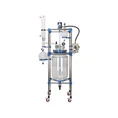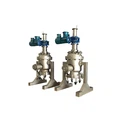What Industries Use Supercritical Fluid CO2?

Have you ever wondered how the rich flavor of your favorite decaffeinated coffee is maintained when it is decaffeinated? Supercritical fluid CO2 extraction, a cutting-edge green technique, is the key-not magic. This potent and accurate technique has transcended the laboratory and is now a vital component of innovation in some of the most demanding sectors in the world.
Supercritical fluid CO2 extraction (SFE) provides unmatched benefits for everything from producing the purest medicinal components to capturing the most delicate floral smells for perfumes. This article will look at the main sectors that use this technology, the scientific underpinnings of its effectiveness, and the reasons it is quickly displacing conventional techniques.
Important Takeaways
- Wide-ranging Uses: A crucial technology in the food, beverage, pharmaceutical, nutraceutical, and cosmetics sectors is supercritical CO2 extraction.
- Superior Purity: The method produces incredibly safe and pure products by using recyclable, non-toxic CO2 that leaves no solvent residue behind.
- Kind to Products: Heat-sensitive substances, such as vitamins, active chemicals, and subtle fragrances, are preserved by low-temperature operation and are frequently destroyed by conventional techniques.
- Highly Selective: Operators can target and remove particular compounds with unparalleled customisation by carefully regulating temperature and pressure.
Understanding Supercritical CO2: The Science Behind the Revolution
To appreciate why so many industries have adopted this technology, it's essential to understand what makes it work. The process hinges on the unique properties of a substance in its "supercritical" state.
What is a Supercritical Fluid?
When a substance is heated and pressurized beyond its specific critical point, it enters a fascinating hybrid state-it is no longer a distinct liquid or gas. This supercritical fluid has the density of a liquid, giving it excellent solvent capabilities, but also the low viscosity and high diffusivity of a gas, allowing it to penetrate solid materials with ease. This unique combination makes it a highly efficient solvent.
Why CO2 is the Ideal Solvent
While other substances can be made supercritical, CO2 is the industry standard for several reasons:
Safety: It is non-toxic, non-flammable, and inert, meaning it won't react with the materials being extracted.
Purity: It leaves absolutely no residue, unlike chemical solvents. Once the pressure is released, the CO2 simply turns back into a gas and evaporates.
Accessibility: CO2 is inexpensive, readily available, and can be recycled within the system with over 95% efficiency, making it an environmentally friendly choice.
Gentleness: Its critical point (31.1°C and 73.8 bar) is near room temperature, making it perfect for extracting delicate, heat-sensitive compounds without causing thermal degradation.
Core Industries and Applications
The versatility of supercritical fluid CO2 extraction has made it an indispensable tool for manufacturers of high-value products.

Food and Beverage Industry
This sector was one of the earliest adopters of SFE, using it to create cleaner, higher-quality products.
-
Decaffeination of Coffee and Tea:
SFE allows for the selective removal of caffeine from coffee beans and tea leaves while leaving the delicate aromatic and flavor compounds intact, something traditional solvent methods struggle with.
-
Hop Extraction for Brewing:
The brewing industry uses SFE to extract alpha acids and essential oils from hops. This produces a consistent, stable, and pure hop extract that enhances the flavor and aroma of beer without introducing unwanted plant matter.
-
Natural Flavor and Spice Extraction:
This is a key area for high-quality Spice Extraction Equipment. SFE can pull rich, concentrated flavors from spices like ginger, pepper, and cinnamon without the harsh heat of steam distillation, resulting in a more authentic and potent product.
Pharmaceutical and Nutraceuticals
In an industry where purity is paramount, SFE provides a solution that meets the strictest regulatory standards, like GMP.
-
Cannabis Oil Extraction:
Perhaps the most well-known modern application, SFE, is the gold standard for extracting cannabinoids. It yields a clean, potent, and residue-free oil, making it the preferred method for medical and wellness products.
-
Extraction of Active Pharmaceutical Ingredients (APIs):
SFE is used to isolate high-purity active compounds from medicinal plants. As a top-tier piece of traditional Chinese Medicine Active Ingredient Extraction Equipment ensures that the final product is potent and free from contaminants.
-
Production of Omega-3 Fatty Acids:
This technology is used to extract and purify delicate omega-3 oils from sources like fish and algae, producing high-quality Health Supplement Raw Material Extraction Equipment that avoids oxidation and degradation.
Cosmetics and Fragrances
The demand for natural, "chemical-free" beauty products has driven the adoption of SFE in the cosmetics industry.
-
Natural Essential Oil Extraction:
As premier Essential Oil Extraction Equipment, SFE gently extracts aromatic compounds from botanicals like roses and lavender. The low-temperature process yields an essential oil with a scent profile that is truer to the original plant than what can be achieved with high-heat methods.
-
Perfume and Aroma Component Separation:
The high selectivity of SFE allows producers to isolate specific fragrance molecules, giving them precise control over the final scent profile of perfumes and other cosmetic products.
Other Emerging Fields
The potential of SFE continues to expand into new and exciting areas.
-
Biomass and Biofuel Production:
SFE is being explored for extracting oils from algae and other biomass sources to create sustainable biofuels.
-
Textile Dyeing and Cleaning:
Supercritical CO2 can be used as a solvent to dye fabrics without using any water, offering a revolutionary, pollution-free alternative for the textile industry.
Advantages of Supercritical CO2 Extraction
Compared to legacy methods, SFE offers clear and compelling benefits in three key areas.
Environmental and Safety Benefits
The use of non-toxic, recyclable CO2 eliminates the need for hazardous organic solvents like hexane or butane. This not only prevents harmful residues in the final product but also avoids the environmental pollution and worker safety risks associated with storing and disposing of chemical solvents.
Product Quality and Purity
The ability to operate at low temperatures is a game-changer for quality. It ensures that delicate vitamins, antioxidants, and aromatic compounds are preserved, leading to a nutritionally and sensorially superior product. The complete absence of solvent residue means the final extract is exceptionally pure.
Process Efficiency and Customization
SFE systems offer unparalleled control. By simply adjusting the pressure and temperature, operators can fine-tune the solvent properties of CO2 to target specific compounds. This allows for fractional extraction, where different compounds can be separated from the same raw material in a single process, maximizing efficiency and value.
Supercritical CO2 Extraction vs. Traditional Methods
How does SFE truly stack up against the old guard of extraction?
| Features | Supercritical CO₂ extraction | Traditional methods (solvent/steam) |
| Purity | >98% (no residual solvent) | 60-85% (residual solvent 0.5-5 mg/kg) |
| Temperature | Low temperature (35-50°C). Preserves the activity of heat-sensitive ingredients. |
High temperature (70-100°C+). |
| Environmental impact | Zero pollution. CO₂ recycling rate: >95%. FDA/REACH compliant. |
High contamination risk. Organic solvent toxicity. Waste disposal costs account for 30% of operational costs. |
| Selectivity | Precise and controllable. Adjust pressure/temperature for targeted extraction (e.g., decaffeination to retain flavor). |
Low precision. Complete solvent dissolution leads to impurity contamination (requiring secondary purification). |
SFE vs. Organic Solvent Extraction
The primary advantage of SFE over solvent extraction is the elimination of residues. While solvent-based methods require additional, energy-intensive post-processing steps to remove the solvent, SFE yields a pure product directly. This not only improves safety and quality but also saves significant operational costs associated with solvent purchasing and disposal.
SFE vs. Steam Distillation
Steam distillation is a common method for essential oils but relies on high temperatures, which can thermally degrade or alter the very compounds being extracted. SFE, with its low-temperature operation, preserves the natural, unaltered profile of the source material, resulting in a higher-quality and more authentic extract.
Choosing the Right Supercritical CO2 Equipment for Your Needs

Selecting the right Plant Extraction Equipment is a critical decision that depends on your specific goals.
Factors to Consider
Scale of Operation: Are you conducting initial research or moving to full-scale production? The required capacity will range from small lab-scale units to large industrial systems.
Material Type: The properties of your raw material (solid, liquid, paste) will influence the design of the extraction vessel and handling system.
Desired Purity and End Product: The level of purity and the need for fractional separation will determine the complexity of the system, such as the number of separators required.

TOPTION's Supercritical Extraction Solutions
At TOPTION, we have over 18 years of experience in manufacturing and customizing high-performance extraction solutions. Our portfolio of supercritical CO2 extraction systems ranges from versatile5L lab-scale models perfect for R&D to massive industrial plants designed for continuous production. We work closely with our clients to engineer turnkey systems that are perfectly tailored to their unique process requirements, ensuring maximum efficiency and ROI.
FAQ
Is Supercritical CO2 Extraction a "Green" Technology?
Yes, it is considered a leading green technology. It uses a non-toxic solvent (CO2) that is captured and recycled, and it avoids the pollution associated with traditional organic solvents.
Can SFE be used to extract both polar and non-polar compounds?
While CO2 is naturally non-polar and ideal for oils and fats, its solvent properties can be modified. By introducing a small amount of a co-solvent (like ethanol), the system can effectively extract more polar compounds as well.
What are the main challenges of using SFE?
The primary challenge is the higher initial capital investment compared to some traditional methods. However, this cost is often offset by lower operating expenses (no solvent costs, less energy for post-processing) and the higher value of the superior-quality product, leading to a strong return on investment.
How is the CO2 recycled in the process?
After the extract is separated, the low-pressure CO2 gas is passed through a condenser, which cools it back into a liquid. This liquid CO2 is then stored in a tank and re-pressurized by the pump to be used in the next extraction cycle. The recycling rate is typically above 95%.
Click here to watch the Molecular distillation of sage essential oil launch!




